 Talk Around Town
Talk Around Town


|
| Illustration by Đàm Minh Chí |
By Nguyễn Hằng
Authorities in Hà Nội are considering a proposal to recover Tô Lịch River, which was once one of the capital city’s most beautiful rivers but has been ruined by serious pollution and the discharge of thousands of cubic metres of untreated wastewater.
Tô Lịch River, with a total length of 14km, runs through six districts of Ba Đình, Cầu Giấy, Đống Đa, Thanh Xuân, Hoàng Mai and Thanh Trì. Its starting point is in Nghĩa Đô Ward, of Cầu Giấy District and the ending point flows to Nhuệ River in Hữu Hòa Commune, Thanh Trì District.
Under the proposal, a pumping station, worth about VNĐ150 billion (US$6.4 million), would be built to carry water from Hồng (Red) River into West Lake and then cleaning it for depositing into Tô Lịch River. The proposed station would have a capacity of 156,000 cubic metres per hour.
The solution is believed to be the cheapest and most efficient for recovering the river, according to Hà Nội Drainage One Member Limited Company – the designer of the proposal.
The move is very welcome.
If the river is really recovered as planned, it will help not only return a beautiful river to the city’s dwellers but also allow the development of tourism services as many other capitals do with their river.
However, concerns over the effectiveness of the project have been raised.
Experts say the project would not solve the root cause of the pollution because the river receives daily hundreds of thousand of cubic metres of untreated wastewater, mostly from households.
Đặng Hùng Võ, former minister of Natural Resources and Environment, said the project would be feasible if all household wastewater was collected and treated.
Trương Mạnh Tiến, president of Hà Nội’s Lake Club, said there must be a comprehensive solution to clean up the river.
"If we select an option based on cost without considering the root cause of the problem, the solution is meaningless," Tiến said.
“The most important thing is treating the household wastewater that constantly pollutes the river,” he said.
Former minister of Agriculture and Rural Development Vũ Trọng Hồng agreed with Võ and Tiến.
Hồng said if the project only used water from the Hồng (Red) River to clean up Tô Lịch River, then the polluted water would flow to Nhuệ River, and Đáy River and return to the Hồng (Red) River because the rivers are connected.
“So, what is the meaning of the project?” he added.
What to do
Offering solutions, Hồng said first, authorised agencies should dredge the river. Second, they had to find somewhere to bury the mud taken from the river. Last, they were advised to collect and treat the wastewater.
While authorities dwell on the proposal to save Tô Lịch River, another project that was originally drawn up in October 2016, remains on paper.
It was a project to build Yên Xá Wastewater Treatment Plan in Yên Xá Village, Thanh Trì District, which was expected to treat wastewater from some local rivers, including Tô Lịch River. Under the project, a plant with a treatment capacity of 270,000 cubic metres per day was scheduled to be finished in October this year. However, the area to build the plant, covering 13.8 hectares, is still covered with weeds.
So, there are several things that Hà Nội needs to do. First, consulting with experts to design a comprehensive solution before approving the proposal; second, boosting the delayed project to bring back the river from the dead; and finally, learning from experiences in recovering dead rivers as the United Kingdom did with its Thames river or as South Korea did with the Han river.
The Han River, once was so polluted by industry and sewage that dead fish lined its banks. In 1892, a five-year engineering project unclogged and cleansed Seoul’s lifeline, transforming the Han into a source of national pride. Among the solutions to recover the dead river, they built four sewage treatment plants and dredged the river to control water levels and flooding.
Hà Nội’s dwellers have been waiting too long to see the return of a clean and beautiful Tô Lịch River. — VNS




